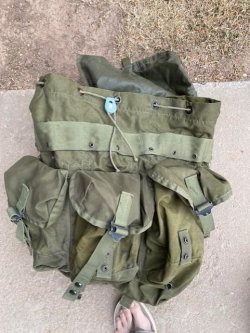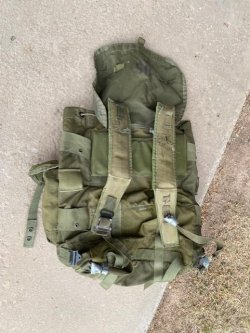I think the key question to ask yourself is if you're going on a camping trip or a hunting trip. If you're going hunting, you aren't going to be in camp except to sleep or if you're stuck in your tent because of weather/visibility. So don't take a bunch of extra junk for camp. I've also been slowly buying very light backpacking camping gear from backcountry mountain focused gear brands, not hunting brands. They have a much bigger customer base, more $$$ for R&D, and the quality is just much better. Although it does seem like hunting brands are starting to catch up, finally. My pack is a Mystery Ranch Metcalf (4333 cu in). The pack itself is pretty heavy but carries weight well. I wouldn't say I'm in love with it, but it definitely works. I went on a 4 night trip recently and my pack was 46lbs with way too much food, and 2 liters of water in my camelback. That weight included my 55mm mini spotter and tripod, but not my binos or rifle. Pack was nowhere near full and nothing was on the outside except my tripod (pretty light) and trekking poles (not light, but probably never going to break one). Binos are always on my chest in a harness unless they're on the tripod and I'm planted somewhere glassing, and rifle is in a Kifaru rifle bearer under the arm but gets strapped to the side of the pack once game is on the ground. Keeping my pack light allows me to move more freely with camp on my back and to carry a heavier rifle that gives me more confidence shooting long (11 lbs loaded).
Extra socks and underwear? I don't pack anything 'extra' anymore, as in a change of clothes. One of each thing. Wear your socks to bed and they're magically dry in the morning no matter how wet they got - I learned that on multi day backcountry skiing and mountaineering trips in the PNW. Changing underwear on a backpacking trip is absolutely useless unless you've **** your pants, in which case you're probably very sick and in a whole world of trouble. The thing I see most people doing is taking too much stuff that they don't even use. Chairs, gadgets, comfort items, and extra clothes. What's the point of extra changes of clothes in the backcountry? Half an hour into the day you're soaked in sweat and they're stinky and dirty again. Wearing extra socks actually makes your feet cold. If you feel like you need extra socks, you really just need better boots. If you can comfortably fit extra socks into your boots, then your boots don't fit. Thin merino socks are very warm. Thick or double socks = blisters because they bunch up and create pressure points. Ask a mountaineer what kind of socks they wear.....they're not thick. They wear warm boots.
Rain gear, an appropriate puffy for the temps you're going to see, a sweater, and a good merino first layer will get you through some very, very cold weather. Get as many items in merino wool as possible, it's warm when wet, cool when you're hot, and odor resistant. Rain gear also provides a huge boost to warmth when sitting and glassing. It's wind proof and keeps all that warm air inside your puffy and your pants. Lightweight tents pack tiny these days and tarps even smaller. A good full size inflatable mattress rolls up to the size of a nalgene bottle. Down sleeping bags compress to a crazy small size. If you keep a couple layers on when you sleep (especially your puffy to keep your core warm), you can get away with a higher temp rated and less bulky sleeping bag, but you do need to be sure you're warm enough to get good sleep! A Sawyer water filter is barely bigger than a roll of quarters. A Jetboil or similar fits a canister with enough fuel for several days and the stove itself inside a 1 liter pot - which is the only pot you need for dehydrated meals and hot drinks. You can probably fit your fire starter kit (I can't imagine how that could be something that's bulky but someone mentioned it as a point of concern) inside there, too. The only thing that changes my pack size is food. I haven't figured out how to shrink that, and I always pack extra. Can't seem to shake that habit. My Metcalf carries all I need for up to a week, although it gets tight with food for that many days.
Extra socks and underwear? I don't pack anything 'extra' anymore, as in a change of clothes. One of each thing. Wear your socks to bed and they're magically dry in the morning no matter how wet they got - I learned that on multi day backcountry skiing and mountaineering trips in the PNW. Changing underwear on a backpacking trip is absolutely useless unless you've **** your pants, in which case you're probably very sick and in a whole world of trouble. The thing I see most people doing is taking too much stuff that they don't even use. Chairs, gadgets, comfort items, and extra clothes. What's the point of extra changes of clothes in the backcountry? Half an hour into the day you're soaked in sweat and they're stinky and dirty again. Wearing extra socks actually makes your feet cold. If you feel like you need extra socks, you really just need better boots. If you can comfortably fit extra socks into your boots, then your boots don't fit. Thin merino socks are very warm. Thick or double socks = blisters because they bunch up and create pressure points. Ask a mountaineer what kind of socks they wear.....they're not thick. They wear warm boots.
Rain gear, an appropriate puffy for the temps you're going to see, a sweater, and a good merino first layer will get you through some very, very cold weather. Get as many items in merino wool as possible, it's warm when wet, cool when you're hot, and odor resistant. Rain gear also provides a huge boost to warmth when sitting and glassing. It's wind proof and keeps all that warm air inside your puffy and your pants. Lightweight tents pack tiny these days and tarps even smaller. A good full size inflatable mattress rolls up to the size of a nalgene bottle. Down sleeping bags compress to a crazy small size. If you keep a couple layers on when you sleep (especially your puffy to keep your core warm), you can get away with a higher temp rated and less bulky sleeping bag, but you do need to be sure you're warm enough to get good sleep! A Sawyer water filter is barely bigger than a roll of quarters. A Jetboil or similar fits a canister with enough fuel for several days and the stove itself inside a 1 liter pot - which is the only pot you need for dehydrated meals and hot drinks. You can probably fit your fire starter kit (I can't imagine how that could be something that's bulky but someone mentioned it as a point of concern) inside there, too. The only thing that changes my pack size is food. I haven't figured out how to shrink that, and I always pack extra. Can't seem to shake that habit. My Metcalf carries all I need for up to a week, although it gets tight with food for that many days.



